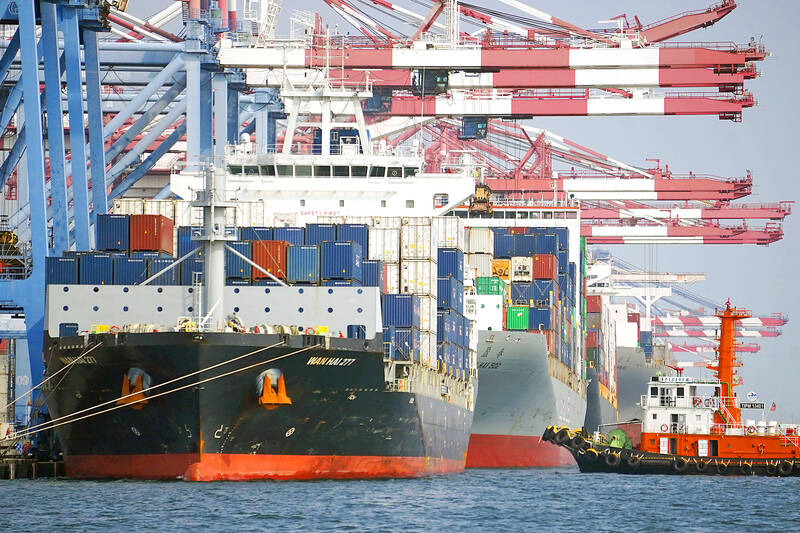The government’s business climate monitor last month flashed a 10th consecutive “blue” signal indicating a recessionary state after all economic indicators remained sluggish, although a decline in exports mitigated the situation, the National Development Council (NDC) said yesterday.
The total value of the nine monitoring components stayed unchanged at 15, making the contraction longer than that during the global financial crisis in 2008, and on par with the downturn during Europe’s debt problems in 2011 and the technology correction cycle in 2015, the council said.
“The score dropped to 10 in February and had since moved slowly upward, suggesting the worst is over,” deputy director of the council’s economic department Chiu Chiu-ying (邱秋瑩) told a news conference.

Photo: CNA
The latest improvement came after the retreat in exports eased, but the data on monetary supply measures worsened, the council said.
Foreign portfolio managers usually take shelter in the US dollar in bad times, while people put money away in time deposits to avoid risk.
Strong artificial intelligence (AI) demand allowed outbound shipments of information and communications technology products to register a rapid pickup last month and the release of new-generation mobile gadgets this month would lead to further growth momentum in the run-up to the Christmas season, Chiu said.
The council uses a five-color system to portray the nation’s economic health, with “green” signifying steady growth, “red” suggesting a boom and “blue” reflecting a recession. Dual colors suggest transition to a stronger or weaker state.
The retreat in industrial output also narrowed for similar reasons, Chiu said.
Domestically, the job market was stable, while retail and dining revenues continued to grow, she said.
However, securities accounts took a downturn as AI shares went through price corrections and weighed on demand for cash and cash equivalents, the council said.
The index of leading indicator series, which aims to foretell the economic scene six months ahead, shrank 0.3 percent to 99.06, it said.
The movement came after business confidence, stock prices and construction floor space gave positive cyclical readings, but labor accession rates and imports of semiconductor equipment deteriorated, the council said.
By contrast, the index of coincident indicators, which reflects the current economic situation, picked up 0.91 percent to 97.48, helped by better data on exports, non-farm payrolls, industrial production and electricity usage, it said.

The US dollar was trading at NT$29.7 at 10am today on the Taipei Foreign Exchange, as the New Taiwan dollar gained NT$1.364 from the previous close last week. The NT dollar continued to rise today, after surging 3.07 percent on Friday. After opening at NT$30.91, the NT dollar gained more than NT$1 in just 15 minutes, briefly passing the NT$30 mark. Before the US Department of the Treasury's semi-annual currency report came out, expectations that the NT dollar would keep rising were already building. The NT dollar on Friday closed at NT$31.064, up by NT$0.953 — a 3.07 percent single-day gain. Today,

‘SHORT TERM’: The local currency would likely remain strong in the near term, driven by anticipated US trade pressure, capital inflows and expectations of a US Fed rate cut The US dollar is expected to fall below NT$30 in the near term, as traders anticipate increased pressure from Washington for Taiwan to allow the New Taiwan dollar to appreciate, Cathay United Bank (國泰世華銀行) chief economist Lin Chi-chao (林啟超) said. Following a sharp drop in the greenback against the NT dollar on Friday, Lin told the Central News Agency that the local currency is likely to remain strong in the short term, driven in part by market psychology surrounding anticipated US policy pressure. On Friday, the US dollar fell NT$0.953, or 3.07 percent, closing at NT$31.064 — its lowest level since Jan.

Hong Kong authorities ramped up sales of the local dollar as the greenback’s slide threatened the foreign-exchange peg. The Hong Kong Monetary Authority (HKMA) sold a record HK$60.5 billion (US$7.8 billion) of the city’s currency, according to an alert sent on its Bloomberg page yesterday in Asia, after it tested the upper end of its trading band. That added to the HK$56.1 billion of sales versus the greenback since Friday. The rapid intervention signals efforts from the city’s authorities to limit the local currency’s moves within its HK$7.75 to HK$7.85 per US dollar trading band. Heavy sales of the local dollar by

The Financial Supervisory Commission (FSC) yesterday met with some of the nation’s largest insurance companies as a skyrocketing New Taiwan dollar piles pressure on their hundreds of billions of dollars in US bond investments. The commission has asked some life insurance firms, among the biggest Asian holders of US debt, to discuss how the rapidly strengthening NT dollar has impacted their operations, people familiar with the matter said. The meeting took place as the NT dollar jumped as much as 5 percent yesterday, its biggest intraday gain in more than three decades. The local currency surged as exporters rushed to